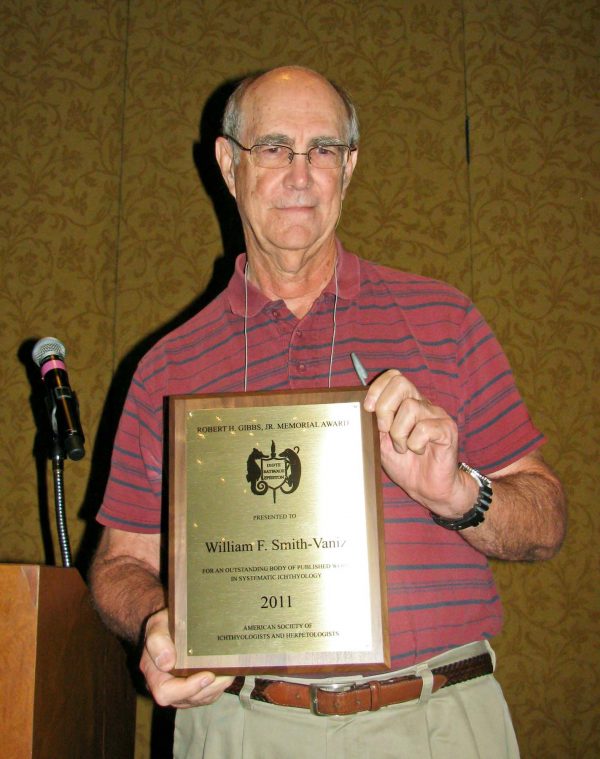Florida Museum of Natural History research associate William F. Smith-Vaniz recently received the most prestigious award available to researchers of the diversity and evolutionary relationships of fishes.

Florida Museum photo by Mary Brown
The Robert H. Gibbs, Jr. Memorial Award for Excellence in Systematic Ichthyology from the American Society of Ichthyologists and Herpetologists is given to one ichthyologist from the Western Hemisphere every year for “an outstanding body of published work in systematic ichthyology.” Smith-Vaniz is the third University of Florida researcher to be honored with the award.
“As his productivity in research and publications built over many decades, I was amazed as to how many families of marine fishes Bill was involved with, by himself or in cooperation with other leading ichthyologists, with regard to fish taxonomy,” said Walter Courtenay, a U.S. Geological Survey ichthyologist, who with another colleague, nominated Smith-Vaniz for the award. “The Florida Museum of Natural History can take pride that three recipients of Gibbs awards are now affiliated there — Larry Page, Bill Eschmeyer and Bill Smith-Vaniz.”
Smith-Vaniz received a plaque and $5,000 award at the annual American Society of Ichthyologists and Herpetologists conference held in Minneapolis earlier this month.
His diverse research includes more than 100 academic publications, shifting from a focus on freshwater to worldwide reef marine fishes. In 1968, following the completion of his master’s in fisheries biology from Auburn University, Smith-Vaniz’s first publication was a book entitled, “Freshwater Fishes of Alabama.”
“I grew up in the Mississippi Delta where hunting and fishing were almost part of the culture,” Smith-Vaniz said. “I was fascinated by fish at an early age – I was just one of those nature kids.”
An avid fly fisherman, his father knew an area fisheries biologist, and Smith-Vaniz was invited to participate in state fish surveys while in high school, an offer he gladly accepted, he said.
“We did those surveys about four days a week all summer long for two years so I got exposed to a lot of fish and that just reinforced my enthusiasm for the diversity of fish,” Smith-Vaniz said. “The biologists knew the game fish very well, but they would categorize about 5 percent as miscellaneous forage fish, and I wanted to know, ‘What species are these fish?’ ”
After working as a museum technician at the Smithsonian Institution for two years, Smith-Vaniz earned his Ph.D. from the University of Miami while working with C. Richard Robins, who also taught Courtenay and Eschmeyer.
“Bill is sort of the last of the old-school, hard-core descriptive taxonomists,” Eschmeyer said.
Smith-Vaniz is known worldwide as an authority on the systematics of jacks. He said he is most proud of the work he did for his dissertation, a 196-page monograph on about 50 species of Indo-Pacific sabertooth blennies, small reef fishes.
“It brought these remarkable fishes to the attention of a wide range of readers, who I hope will be stimulated to continue studying them,” he said.
Smith-Vaniz worked at the Academy of Natural Sciences of Philadelphia for 20 years before moving to Gainesville in 1992 to work for the U.S. Geological Survey. He retired from the USGS in 2007.
“I’m still about as active in research as I could possibly be, probably even more so since I retired,” Smith-Vaniz said. “Like everybody, I’m working on too many projects simultaneously – despite all those fish in all those collections, there’s still a tremendous amount of research that needs to be done.”
The field of fish systematics has progressed immensely since Smith-Vaniz began his career in the 1960s and he said the Internet and advances in molecular technologies have had the greatest impact. But he warns up-and-coming ichthyologists not to depend solely on molecular data.
“Because of the Internet now, it’s so easy with digital photography to get wonderful documentation of color patterns and the public can learn so much about these fish and have a lot more appreciation for them than ever before,” he said. “If you want to look at the health of the planet, you need to know the ecology, diversity and distributions of these fishes, otherwise you’re not going to detect changes until it’s catastrophic, and at that point, it may be too late to do anything about it.”
Learn more about the Ichthyology Collection at the Florida Museum.